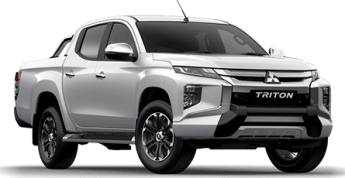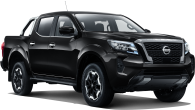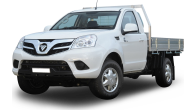Mitsubishi’s Triton is a truck of the times – a dual-cab that’s a quiet achiever in a dual-cab obsessed market.
Did you know that to date the Triton was number three in the 2019 4x4 sales race? It’s outpaced only by segment heroes that you’re always hearing about – the Toyota HiLux and Ford Ranger – two utes which carry significant price premiums to go with their leading market positions.
Despite a significant overhaul this year, the Triton takes a different path, instead choosing to offer consumers something that Mitsubishi is traditionally very good at... value.
The car we tested here is the second from top-spec GLS 4x4, and to boot, it was fitted with the kinds of accessories many Aussies are choosing to kit out their dual-purpose daily driver with.
Which leaves us with a few questions. Is the Triton as good value as it appears? And, should you choose the genuine Mitsubishi accessories, or would you be better off going third party?
We took a week with the GLS to find out.
Mitsubishi Triton 2020: Gls (4X4)
| Engine Type | Diesel Turbo 4, 2.4L |
|---|---|
| Fuel Type | Diesel |
| Fuel Efficiency | 8.6L/100km (combined) |
| Seating | 5 |
| Price From | $30,910 - $37,290 |
| Safety Rating |
|
Does it represent good value for the price? What features does it come with?
8 / 10
As mentioned, the GLS is second from the top in the Triton range and wears a base MSRP of $47,640. Already, the value is apparent. It stands up very well against the equivalent HiLux SR which is not quite as well equipped or flashy, yet still lands with an MSRP of $49,515.
It also stands up well to the equivalent Ranger, the XLS, which is perhaps slightly better equipped but wears an MSRP of $51,640 in automatic form.
To boot, Mitsubishi almost always has some kind of promotion running. At the time of writing you could get this GLS for $45,990 drive-away (less than MSRP!) with an extended seven-year warranty and two years of included service costs.
.jpg)
Standard equipment on the GLS includes tough-looking 18-inch alloys, a 7.0-inch multimedia touchscreen with Apple CarPlay, Android Auto and digital (DAB+) radio support, Bluetooth and HDMI connectivity, dual-zone climate control, keyless entry and push-start, auto headlights and wipers, auto-dimming rear vision mirror, front and rear parking sensors with reversing camera, and oddly, halogen headlights with LED DRLs and high-beams.
That wasn’t quite all on our test car, though. We had a slew of genuine Mitsubishi accessories fitted which ended up adding a surprising amount to the price.
.jpg)
These included the front protection bar with fog lights in a sprayed black finish ($3984), an LED light bar ($695), a chrome door garnish ($570), a soft tonneau cover ($686), a towbar kit ($1120), a 50mm chrome towball ($35), and of course, towball cover ($5).
Oddly, Mitsubishi didn’t think to fit our car with perhaps the only item some prospective buyers might actually want factory-fitted – the tub liner kit ($572 – looks cool with the Mitsubishi Motors branding).
.jpg)
Regardless, that brings our test car up to a non-promotionally priced MSRP of $54,735. Maybe think about waiting for one of those promotional periods if you want some of those items bundled in at under $50K.
The Triton continues to be great value on the balance of spec though. You can easily spend that extra $5 or $10K to get a non-accessory equipped rival.
Is there anything interesting about its design?
8 / 10
Mitsubishi’s ‘Dynamic Shield’ update to the Triton was as dramatic as it was controversial when it was revealed, but I’m a fan.
.jpg)
It’s tough and futuristic – decisively more modern on the outside than the HiLux, D-Max, or even Navara.
I like all the tough angles, almost excessive use of chrome (which you can hardly see with the bullbar fitted), and subtly updated, more angular rear.
.jpg)
The GLS wheels are great with their two-tone finish. You might not like the overall look, and that’s fine. Lots of people prefer the American styling of the Ranger.
The inside has had a much-needed update, too, to bring the Triton in line with its wagon-bodied Pajero Sport twin. There’s an overhauled steering wheel with updated controls, a slicker, more refined dash finish with a pleasing symmetry to it, and a few upgraded materials throughout.
Sadly, the materials and finish are still where you can tell the difference between the Triton and more expensive rivals. There are simply nicer plastics to be found in the HiLux and Ranger.
.jpg)
It seems like the cloth-trimmed seats have not changed at all from the previous Triton. They still have a very mid-2000s look and feel. The comfort level is okay, but I hate the look of them. You’ll have to step all the way up to the GLS Premium to get better (partial leather) trim.
Still, there’s something to be said for the relative simplicity of it. You won’t feel bad about treading mud and gravel through it, nor will you feel bad about loading the cabin up with work gear or disheveled colleagues. It’s built for it and looks it.
How practical is the space inside?
8 / 10
The Triton scores many points here, starting with the telescopic adjust for the steering column, as well as a practical set of four bottle holders for front passengers (two in the console, two in the door), trenches in the doors and centre console, and a deep console box.
.jpg)
The rear seat gets the same simple and ugly seat trim but does benefit from a large adjustable air-conditioning outlet in the roof, a small trench on the back of the centre console, and a USB outlet. There are small bottle holders in the doors.
It’s worth noting the Triton can only have two child seats back there as there are two ISOFIX locations or two top-tethers. The narrow centre seat is barely usable – even for adults. Other than that legroom on the outboard rear seats is fine but not stellar. The VW Amarok is wider, and the Ranger offers more legroom.
.jpg)
The tray measures 1470mm x 1520mm x 475mm although it cannot fit a standard Australian pallet between the wheelarches. Our truck had a tonneau cover, but it felt bad loading it with cargo when there’s no bed liner… definitely get that option if you’re going to use the stock tray.
At 3100kg for the 4x4 auto, towing capacity is below the industry standard 3500kg, while the payload for this particular spec is 910kg.
What are the key stats for the engine and transmission?
8 / 10
Mitsubishi’s 2.4-litre four cylinder, turbo-diesel engine produces a healthy 133kW/430Nm – almost on par with the HiLux despite being a slightly smaller capacity.
.jpg)
It’s a proven solution that won’t throw up red flags. These days you can have more power from smaller capacity turbos (Ford Ranger) or more expensive V6s (VW Amarok), but the Triton will prove just fine for most buyers.
The GLS has a six-speed torque converter automatic transmission, capable of both high- and low-range via Mitsubishi’s well-regarded 'Super Select II' 4x4 system.
The system also has modes for 4H and 4L with the rear differential locked.
How much fuel does it consume?
7 / 10
The claim is this version of the Triton will consume 8.6L/100km of diesel on the combined cycle, and over very ‘combined cycle’ real world testing our truck returned 9.9L/100km.
About right given I saw almost exactly the same discrepancy between claimed and real-world on my recent test of the HiLux SR5.
All 4x4 Tritons have 75-litre fuel tanks and drink diesel.
Warranty & Safety Rating
What safety equipment is fitted? What safety rating?
7 / 10
By the time you get to GLS spec the Triton has a rather comprehensive list of active safety items. Auto emergency braking (AEB – with pedestrian detection), blind spot monitoring, lane departure warning, auto high beams, and rear cross traffic alert round out the active safety offering.
.jpg)
That’s better than many competitors, although it would be nice to see the addition of lane keep assist and active cruise.
Other noteworthy safety inclusions for a dual cab are hill start assist, hill descent control, and trailer sway control.
The Triton has seven airbags and two ISOFIX child seat mounting points on the outboard rear seats. It carries its maximum five-star ANCAP safety rating across from the previous Triton which was assessed in 2015.
What does it cost to own? What warranty is offered?
8 / 10
Mitsubishi’s Triton is covered by a five year/150,000km warranty. On the one hand, the limited kilometres is a bit of a downer when many competitors offer unlimited distance, but on the other, the brand frequently features a promotional seven-year (but still 150,000km…) coverage, rivalled only by the SsangYong Musso.
The Musso and many other competitors edge in front on the capped price servicing, however. Mitsubishi only offers three years of capped prices.
They are cheap at just $299 per yearly 15,000km visit, and while Mitsubishi is known for reliability, the numbers still don’t provide peace of mind for the length of the warranty.
At the time of writing, the first two years of servicing (valued at $589) were included.
What's it like to drive?
7 / 10
If you’ve driven a Triton before, the new version will offer up little in the way of surprises. It’s largely the same feel.
The seating position is high, and visibility out of the cab is quite good. The Triton offers telescopic (as well as height) steering adjust, too.
_0.jpg)
The engine is exactly what you’d expect, and unchanged from the previous Triton. It pulls just as well as a HiLux despite the difference in capacity, and should offer owners no complaints when it comes to non-V6 power.
The transmission was fine, behaving as you'd expect an old-fashioned torque converter to.
It initially feels very good on the road. It’s composed and firm, giving it a nice feel on the tarmac. After a while, though, you start to find a few issues with it. The steering is accurate, but firm to a fault, becoming tiresome after long periods of driving.
.jpg)
The suspension, too, has a little give and take. It’s still fantastic, but can become unsettled over repeated small bumps and corrugations. It deals with large bumps much better, never feeling too sharp. In some ways it has the opposite ride from the HiLux which is a little too sharp around the rear.
There’s a cheap feeling to the pedals when it comes to feedback. You have to press the brake pedal damn hard to get a significant response, and there’s a lightness to the first five or 10 per cent of each pedal's travel that’s a bit chintzy.
In terms of car-like handling, we found on a recent comparison test that better can be had from the Ranger and Amarok, but for the rugged ute feel the Triton outperforms the HiLux and D-Max, feeling about on-par with the Holden Colorado.
Verdict
The Triton proves to be a solid dual-cab value offering, with its recently updated face entering the fray with excellent equipment at a low price.
It will no doubt be a thorn in the side for market leaders for years to come – but be aware that you get what you pay for. While the Triton might be an excellent value offering there are a few small areas where you can tell the corners have been cut.
Still, it’s impressive that the Triton feels so ahead of the curve while being only a major facelift over its previous iteration.
Pricing Guides






.jpg)


.jpg)
.jpg)
.jpg)













.jpg)
